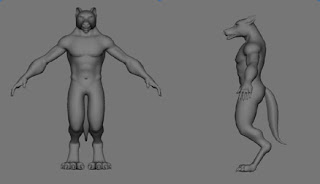Version 01-
I wanted to concentrate on the rigging and animation, so I decided to create the model using already build models and tweak them for the desired look. During the Easter holidays, I started creating the model in Softimage. I collected online images of werewolf and used it as a reference to create the model. Most of the images had a heavy beastly look for the werewolf and I went along with the references. I retopologised the Softimage human rig model for the body and tweaked it to the kind of look I wanted for my model. For the face, I found a 3Ds Max model, but the topology of the mesh was not correct at all. I imported it into Softimage and started retopologising it, but at some point, I realised that I will have to create the face mesh from scratch itself. I used a canine leg mesh for my model, which was still work in progress, I was not satisfied with the topology as it was too complex and I didn't need that level of complexity in the model.
The following are the images of the model (WIP) I had created by the end of Easter holidays.
Version 02-
During my second presentation after the Easter holidays, I told everyone about the change of concept. While I discussed the new concept, my tutors were not quite happy with the design of the model; it had a typical Van Helsing werewolf look. They suggested me to explore at non-conventional werewolf designs like the werewolf in Harry Potter. They advised me to revise the character design with a skinny and lean look. I am planning to add a deformation rig for the muscles, so reasoned why I needed a body builder kind of character. Saf mentioned that Bruce Lee has muscle and they are obvious but still he does not have a heavy look. I too agreed to his point and understood the difference a unique character would give to my demo reel.
I decided to freelance the model to my friend Samir and invest more time into rigging research. I sent some reference images to him addressing the kind of look I wanted and sent him other research materials for the anatomy of werewolf. After few days, he did send me a model, but he did not follow the specifications I had given him. I cannot use this model though it has a good topology, as it looks more like a human-dog rather than a werewolf. Following are the images of the werewolf model he had created.
Version 03-
This is my final version of the model.
I had to correct the topology of the torso as it is very important for the deformation ig. I decided to spend more time correcting the model so that during the rigging stage I wouldn't face much troubles.
My turntable for the model-





You need to make the foot diameter larger to carry the weight. Depending on the origin of the werewolf will also determine their bulk i.e. North American werewolf being kin to the Grey Wolf tend to be more heavily built, however the werewolves of the middle east tend to be much lighter in buld i.e. Ethiopian wolf.
ReplyDeleteThere is still a lot of controversy regarding how werewolves are made. It is well accepted that the initial infection is via the transmission of the werewolf virus using some fluid medium (saliva/blood/semen). However whether werewolves are fertile after the change or that the act of mating just serves to distribute the virus is still under review. Since after the virus has infected all of the cells (and thus enables the transformation) the transmission of any cell to a new host will cause that host to become a werewolf.